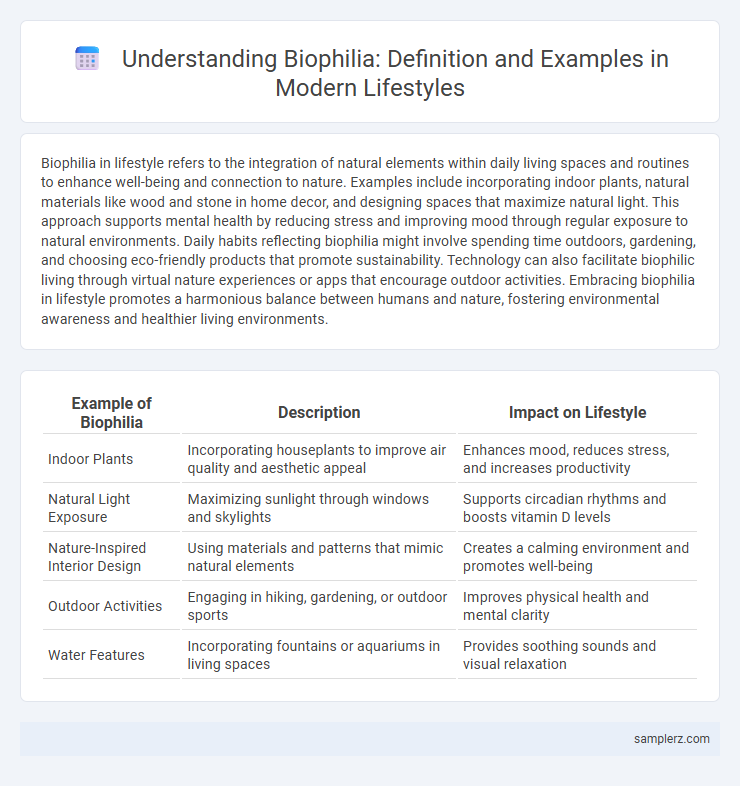Biophilia in lifestyle refers to the integration of natural elements within daily living spaces and routines to enhance well-being and connection to nature. Examples include incorporating indoor plants, natural materials like wood and stone in home decor, and designing spaces that maximize natural light. This approach supports mental health by reducing stress and improving mood through regular exposure to natural environments. Daily habits reflecting biophilia might involve spending time outdoors, gardening, and choosing eco-friendly products that promote sustainability. Technology can also facilitate biophilic living through virtual nature experiences or apps that encourage outdoor activities. Embracing biophilia in lifestyle promotes a harmonious balance between humans and nature, fostering environmental awareness and healthier living environments.
Table of Comparison
| Example of Biophilia | Description | Impact on Lifestyle |
|---|---|---|
| Indoor Plants | Incorporating houseplants to improve air quality and aesthetic appeal | Enhances mood, reduces stress, and increases productivity |
| Natural Light Exposure | Maximizing sunlight through windows and skylights | Supports circadian rhythms and boosts vitamin D levels |
| Nature-Inspired Interior Design | Using materials and patterns that mimic natural elements | Creates a calming environment and promotes well-being |
| Outdoor Activities | Engaging in hiking, gardening, or outdoor sports | Improves physical health and mental clarity |
| Water Features | Incorporating fountains or aquariums in living spaces | Provides soothing sounds and visual relaxation |
Integrating Indoor Plants for Wellness
Integrating indoor plants into living spaces enhances air quality and reduces stress by promoting a connection to nature, which supports mental and physical wellness. Popular choices like snake plants, pothos, and spider plants are low-maintenance yet highly effective for improving indoor environments. Incorporating greenery in workspaces and homes encourages productivity, creativity, and overall well-being through biophilic design principles.
Natural Lighting in Home Design
Natural lighting in home design enhances well-being by connecting indoor spaces with the outdoors, reducing dependence on artificial light and promoting circadian rhythm regulation. Incorporating large windows, skylights, and open floor plans maximizes sunlight exposure, creating a calming and energy-efficient environment. This biophilic approach not only improves mood and productivity but also supports sustainable living practices.
Sustainable Materials in Everyday Life
Sustainable materials such as bamboo, cork, and recycled fabrics are increasingly integrated into everyday lifestyle products, enhancing biophilic design by connecting people with nature. These eco-friendly materials reduce environmental impact while promoting health and well-being through natural textures and organic aesthetics. Incorporating sustainable resources into furniture, clothing, and home decor supports a lifestyle that values harmony with the environment and fosters a deeper connection to the natural world.
Forest Bathing as a Daily Practice
Forest bathing, or shinrin-yoku, immerses individuals in natural forest environments to reduce stress and improve mental clarity, promoting a sustainable lifestyle rooted in biophilia. Regular engagement with forest ecosystems enhances emotional well-being, lowers cortisol levels, and supports cardiovascular health through mindful sensory connection to flora and fauna. Incorporating forest bathing as a daily practice fosters a deep, instinctual relationship with nature that revitalizes both body and mind.
Nature-Inspired Decor Trends
Nature-inspired decor trends in lifestyle emphasize biophilia by integrating organic materials such as wood, stone, and natural fibers to create a calming indoor environment. Incorporating indoor plants, living walls, and botanical prints enhances air quality and promotes psychological well-being by connecting individuals with nature. Earthy color palettes, natural light, and textures that mimic natural landscapes contribute to a harmonious and rejuvenating living space aligned with biophilic principles.
Outdoor Living Spaces at Home
Incorporating biophilia into outdoor living spaces at home enhances well-being by integrating natural elements like plants, water features, and natural materials. Designing patios with abundant greenery, comfortable seating, and organic textures promotes relaxation and connection to nature. Effective use of sunlight, fresh air, and natural scents in these spaces supports mental health and reduces stress.
Urban Gardening for City Dwellers
Urban gardening exemplifies biophilia by integrating natural elements into city dwellers' daily lives, promoting mental well-being and air quality improvement. Rooftop gardens, balcony planters, and community green spaces enable residents to connect with nature despite limited outdoor access. Such practices enhance biodiversity, reduce urban heat islands, and foster sustainable living in metropolitan environments.
Mindful Nature Walks in Routine
Mindful nature walks enhance lifestyle by fostering a deep connection with the environment, promoting mental clarity and stress reduction. Integrating biophilia through regular outdoor walks supports emotional well-being and improves focus by immersing individuals in natural sensory experiences. This practice aligns with sustainable living trends, encouraging awareness of biodiversity and ecological balance in daily routines.
Eco-Friendly Home Accessories
Eco-friendly home accessories such as bamboo furniture, recycled glass decor, and organic cotton textiles exemplify biophilia by integrating natural materials into everyday living spaces. These sustainable products enhance indoor air quality and promote a deeper connection to nature, fostering well-being and environmental responsibility. Incorporating plants alongside eco-conscious items further strengthens the bond between humans and the natural world within the home.
Bringing Nature Sounds Indoors
Incorporating biophilia into lifestyle by bringing nature sounds indoors enhances well-being and reduces stress levels. Using sound machines or digital apps featuring rain, birdsong, and ocean waves creates a calming indoor environment that mimics natural settings. Research shows exposure to natural sounds improves concentration, lowers blood pressure, and promotes mental clarity.

example of biophilia in lifestyle Infographic
 samplerz.com
samplerz.com